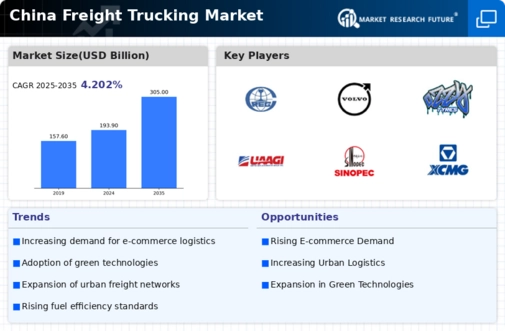Regulatory Changes
Regulatory frameworks governing the freight trucking market in China are evolving, which may significantly impact operational dynamics. The government has introduced stricter emissions standards aimed at reducing pollution from heavy-duty vehicles. These regulations could compel trucking companies to invest in cleaner technologies, potentially increasing operational costs in the short term. However, compliance with these regulations may also lead to long-term benefits, such as improved fuel efficiency and reduced environmental impact. The freight trucking market is likely to experience shifts as companies adapt to these regulatory changes, balancing compliance with operational efficiency.
Rising Consumer Demand
The increasing consumer demand for goods in China is a crucial driver of the freight trucking market. As disposable incomes rise, consumers are purchasing more products, which necessitates efficient logistics and transportation solutions. The freight trucking market is expected to benefit from this trend, as companies strive to meet the growing demand for timely deliveries. In 2025, the retail sector in China is projected to reach approximately $6 trillion, further amplifying the need for robust trucking services. This surge in consumer demand is likely to stimulate growth in the freight trucking market, as logistics providers enhance their capabilities to cater to evolving consumer preferences.
Infrastructure Development
The ongoing enhancement of transportation infrastructure in China plays a pivotal role in shaping the freight trucking market. Investments in highways, bridges, and logistics hubs are expected to facilitate smoother and more efficient freight movement. According to government reports, the Chinese government allocated approximately $150 billion for infrastructure projects in 2025, which is likely to bolster the trucking sector. Improved infrastructure not only reduces transit times but also minimizes vehicle wear and tear, thereby lowering operational costs for trucking companies. As a result, the freight trucking market is poised for growth, driven by these infrastructural advancements that enhance connectivity and accessibility across regions.
Technological Advancements
Technological advancements are reshaping the freight trucking market in China, with innovations such as telematics, route optimization software, and autonomous vehicles gaining traction. These technologies enhance operational efficiency, reduce costs, and improve safety standards within the trucking industry. For instance, telematics systems allow for real-time tracking of shipments, which can lead to better decision-making and resource allocation. As companies increasingly adopt these technologies, the freight trucking market is likely to witness a transformation in service delivery and operational practices, potentially leading to increased competitiveness and profitability.
Logistics Network Expansion
The expansion of logistics networks in China is a significant driver of the freight trucking market. As companies seek to optimize their supply chains, the establishment of new distribution centers and warehouses is becoming more prevalent. This expansion facilitates quicker access to markets and enhances the efficiency of freight operations. In 2025, it is estimated that logistics costs in China will account for around 14% of GDP, indicating the critical role of logistics in the economy. The freight trucking market is expected to thrive as businesses invest in expanding their logistics capabilities, thereby improving service levels and customer satisfaction.



















Leave a Comment